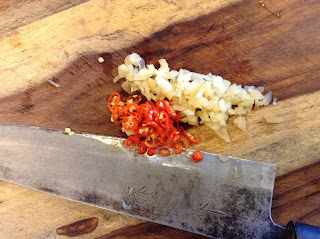Are you really eating a pig head? Well, yeah! Sticky, gelatinous goodness with earthy spices and chili; what could be better.
In South Louisiana, hogshead cheese appears throughout our grocery stores and on many restaurant charcuterie boards. Cooking down a pig head with various herbs and spices is a common practice among professional and amateur Cajun/Creole cooks, and it is a tasty treat when done properly. The pig organs release a gelatin which creates an aspic that allows the ingredients to mold into a terrine. The technique originated in Europe, and possibly due to the French influence it became common in Vietnam. Although slightly different, the version made in Vietnam is more gelatinous and has an earthy taste with the addition of five spice powder. Traditionally, this is a layer in a banh mi dac biet (combination sandwich), and gio thu is a staple during Tet when it is eaten with sweet and sour mustard greens. I enjoy slicing it thinly, wrapping it in Vietnamese coriander and cilantro, and dipping in nuoc mam.
Make sure the meat is washed and cleaned thoroughly. The head should have the brains removed, and the tongue should be peeled of the outer layer (this can be done after the boiling period).
Gio Thu-
Hogshead
1 pig face- cheek meat and snout attached
2 pig ears
1 pig tongue
5lbs. pork bones
1 cup dry
fungus-*
1 tbsp sesame oil
2
shallots minced
3 cloves
garlic minced
4 tbsp
fish sauce-*
1 tbsp Chinese five spice powder-*
1
tbsp red chili flakes
1 tbsp
coarse ground black peppercorns
*- can be found at your local Asian market
Soak the dry fungus in water while you prepare the meat. Rinse off all the meat and thoroughly clean all parts. Boil all the pig meat for about 45 minutes until the ears are tender when you push your fingernail into them. Your nail should leave an indentation. Rinse the meat under cold water to prevent discoloration. When it cools enough to handle, peel the outer layer off the tongue (if you haven't done so), slice the ears, and cut the other pieces into a large dice.
In a large pan or wok, heat sesame oil. When very hot, add shallots and garlic, stir fry quickly until aromatic, then add fungus and meat. Cook on medium high heat stirring gently to begin releasing the natural gelatin. After a few minutes, add fish sauce and spices. Cook until the meat and fungus become sticky.
Line a mold with plastic wrap, and fill with meat. Seal tightly, and place a weight on top to press it down overnight. After about 24 hours, unmold and slice thinly. Traditionally, this is a layer in a banh mi, but it can also be eaten as a snack with herbs and nuoc mam.
The toughest decision of the day- Metal? Punk? 80's? Rockabilly? Hmm, not sure, I know the answer. The Cult was the background music of choice and helped shape my view of Rock & Roll. Now back in the early to mid 80's, Ian Astbury and Billy Duffy blasted into the American rock scene with a sound that crossed over numerous genres. I remember a trip to LSU with the Cult's Electric album blasted over the speakers of my buddy's parent's station wagon! She Sells Sanctuary remains a staple of 80's satellite radio. Manly food such as gio thu needs manly music, and the Cult is a nice injection of testosterone.
Time for a drink!! Beer! I rarely drink beer, but sometimes I just enjoy the cold refreshing taste. Tin Roof Blonde Ale...the Baton Rouge brewery gives us a nice beer to pair with pig parts and a bonus- a purple and gold can so we can think of the LSU Tigers with every sip!








































